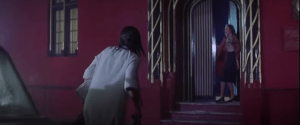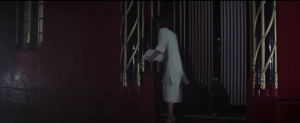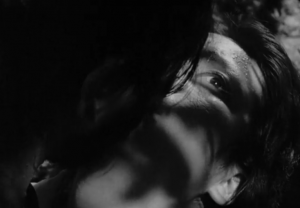This is a segment that I produced, wrote, and filmed for Koug-TV.
Month: November 2021
How Suspiria Terrorizes the Audience With Cinematography
Watching Dario Argento’s Suspiria is a journey. The plot is relatively simple, however, the cinematography works in conjunction with the sound and editing to provoke fear and confusion in viewers. This movie is not good due to its plot; it is good because of how well made it is. Argento takes you down a dark path in this film, where you can’t tear your eyes away, and one of the main factors that contribute to that is the cinematography, making the film so visually interesting and symbolic.
The first shot that I chose is the opening shot, which goes on from 1:25 to 1:38.

It starts out by showing the flight times, then moves diagonally towards the bottom right to show the passengers exiting the airport. Suzy is among them, and until it cuts away to her there is nothing to show that she is our main character.
Already, we can see the use of color in the film, the saturated reds, and greens. Red is also a very important color in the film that appears a lot. The saturated colors offer an immediate shock – this is the opening scene of the movie and already it does not look like the world we know. The movement in this shot is slow, giving us no reason to panic so far. It is a wide shot, establishing where Suzy is coming from, which is not here. Just like Suzy is arriving in this town, we are arriving at this movie.
The second shot that I chose is a relatively long shot, going on from 0:05:46 to 0:06:23.


It starts out with the cab framed in the left foreground, the door to the dancing institution in the right background. Then, the camera moves to the right, and the car moves out of sight, moving the focus more to the door, the new girl in it, and our main character going there with her things.
There is more red in this scene. The aggressive red we see here on the outside of the building appears again in the dancing room, “the red room,” the wine, and most importantly, the blood of the victims. Because of this very saturated red, and other very saturated colors we see in this movie, it feels very stylized. Another color we see used here is white – Suzy is wearing white, symbolizing her innocence, coming to the school, knowing nothing, and murder hasn’t happened yet. The framing of Suzy and the girl in the door ensures that the frame is filled up, and the girl talking to someone off-screen at the same time that Suzy is getting her things together out of the cab to go inside. This is clever because it keeps it visually interesting, and we are experiencing it the same way Suzy is – something important is happening, but she cannot directly focus on it, just as the shot is not directly focused on it. The camera continues moving right, slowly zooming in to completely focus on the door as Suzy gets there and the other girl runs away. We end up with this shot:
Throughout this whole shot, the movement is focused around Suzy, following her. She is the main character, and the cinematography gives us that impression and establishes that even further with this. The other girl is there in the literal background, a side story that is soon to end with a murder.
It seems the director Argento likes to use slow, drawn-out, moving shots in multiple places in his film. Another place this shot is used is in the first murder scene when the camera shows us the victim hung up, and then a shot of below the wait, blood dripping, camera moving down and then left to show the friend who is impaled. This draws us in as we are waiting to see where the camera will go next, what it will show us, and can also serve to make the film feel more natural. I also think it provides a juxtaposition to when murders or other shocking things are happening and we have short scenes, little movement, and quick hard cuts. All in all, Suspiria is a film that utilizes its cinematography incredibly well to draw in the audience and get a reaction out of them.
Mis-en-scene in Rashomon
I chose the film Rashomon to write on its use of mis-en-scène. The first shot that I would like to write about is this scene at 4:20.

This building they are in, Rashomon, is introduced immediately and we come back to it throughout the film, so it is very important. The setting is this old, falling apart, wooden building or temple in the rain. The rain is important because it adds to the dreary mood (the rain is actually dyed black) and it is also the situation that is forcing these characters together because they are taking shelter from it. The state of the building, clearly falling apart, the commoner even ripping wood off the walls to feed their fire at one point, adds to this darker mood. The dyed rain makes for a small stylized effect, but the rest of the setting is less stylized. The commoner’s pants are ripped, the priest has old-looking robes, and the other man does not have the best clothing either. This insinuates that none of them are very wealthy, and some of them are pretty bad off. This shot has softer lighting, but it is not the softest. I also think it can be harder to tell in black and white films. Shadows of characters and the building are clearly visible. For the two characters sitting, this is frontal lighting, which ends up lighting the commoner from behind (also making his shadow very clear) before he sits down with them. The lighting looks more natural. The performances are relatively realistic, with only the priest possibly exaggerating a bit with his horrible musings about what it all means. The actors are all coming pretty close together, creating a relationship that they are in to hear this story out and think about it altogether. This shot employs more deep space, as everything in the background is also in focus. I believe this may be to emphasize the depth of the different stories we are about to hear, it is not simple and they are reinforcing that.
The next scene I chose was this shot at 31:15.

When I first saw this scene, it greatly intrigued me because of the shot that is cut in with this, of the sun through the trees overhead, originally whirling and then still. I will write about that shot as well as the one I have shown here since they go together. The lighting in this shot is hard and low-key, as we can very clearly see the deep shadows across the woman’s face. The woman’s eyes are clearly looking above, so when we see the intercut shot of the sun through the trees, it is implied that it is from her perspective, looking up. The bandit is clearly forcing himself upon her, and in the sun through the trees short, it is whirling around, the camera spinning, perhaps showing her disorientation. In this shot, we can see her looking up as her looking away and dissociating, further supported by the final sun/trees shot where it just appears to move in and out of focus. She doesn’t want to think about what is happening, her personal space being invaded, her body being violated, so she looks away and tries her best to distract herself.